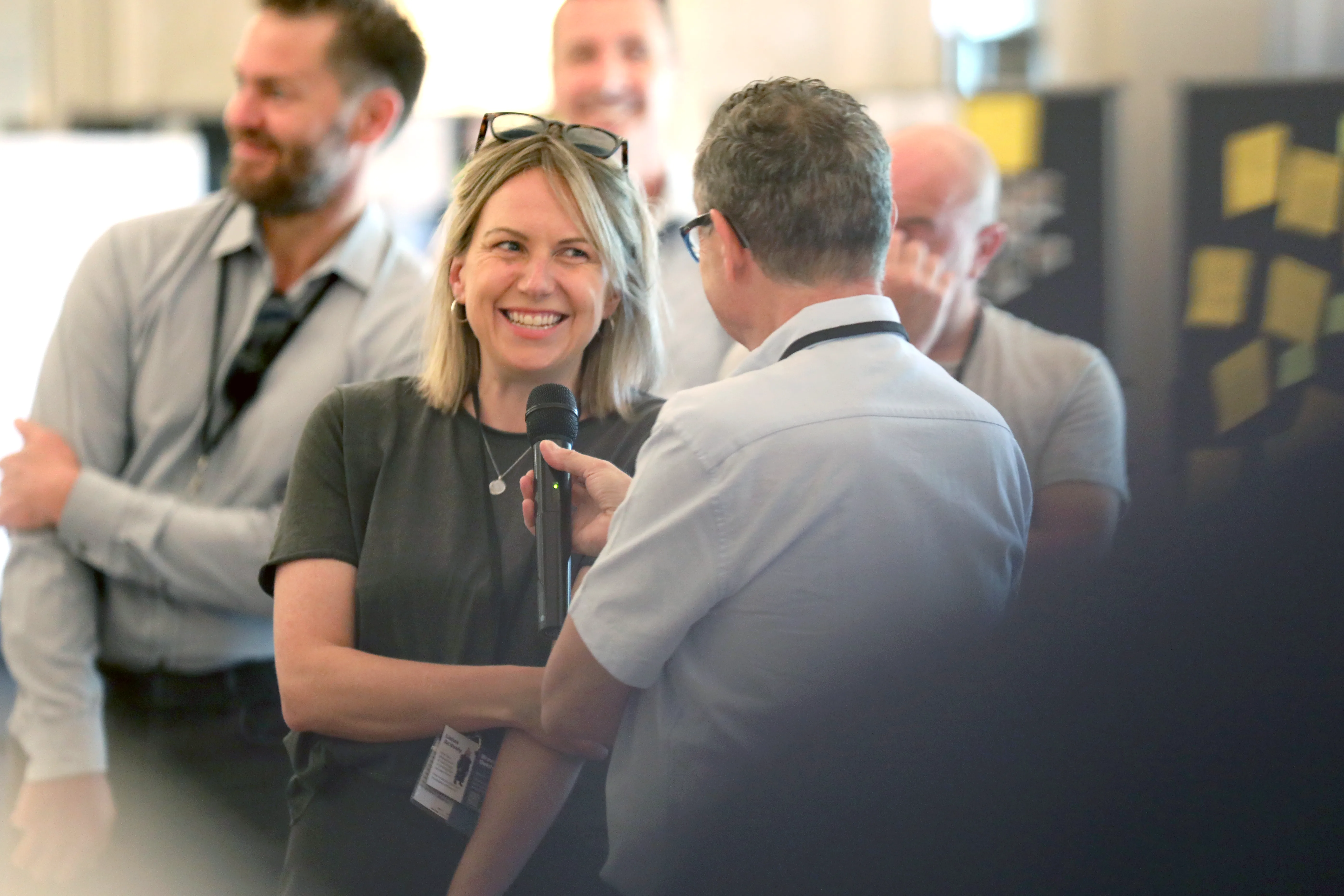What is a Cross-Functional Team?
There’s a lot of talk about cross-functional teams, and it all seems pretty obvious. Collaborate across teams, get different viewpoints in the room, you’re bound to get a better result. Easy enough. Well, no, not entirely.
Why do we (consultants) frequently have to help our clients to pull together and get the best out of real cross-functional teams? Because it’s not just about ‘people in the room’.
You need to think about Why, Who and How. Oh, and you need to deliver WIIFM!
Why
It’s critical to be thoughtful and honest about why you’re bringing together a cross-functional team. If people suspect they are there to rubber-stamp decisions, or to be cornered into agreeing, or just to create the impression of collaboration when they’re not really being asked to contribute… well, they won’t turn up, or they’ll be disruptive. It’s a big commitment of time and energy, so there has to be a business-critical reason. Talk honestly about the blind spots you’re aiming to identify, the co-ordination between teams that’s needed, and the different expertise that’s essential to the project.
We know that people are best motivated when they feel autonomous, so ensuring that teams understand why they’re there and the wider purpose you’re serving is vital. Daniel H Pink puts this brilliantly in Drive: The Surprising Truth About What Motivates Us: "While complying can be an effective strategy for physical survival, it's a lousy one for personal fulfilment. Living a satisfying life requires more than simply meeting the demands of those in control. Yet in our offices and our classrooms we have way too much compliance and way too little engagement. The former might get you through the day, but only the latter will get you through the night."
Who
Too many collaborators is as problematic as too few, so this isn’t a call to just invite everyone you can think of. But, think widely and critically about who your stakeholders are. The organisation needs to believe that all points of view were represented and taken into account, if they are to get behind something ambitious.
Include representatives of the major decision makers – finance, operations and HR will all need to sign off on any big developments. Given them a chance to be involved from the start, so they don’t feel they’re presented with a ‘done deal’ at the last minute. Is the customer and/or consumer truly in the room? Sales leaders are helpful, but an experienced Field Sales rep knows exactly what your customers think. And market research insights are valuable, but your consumer services team hear about the product strengths and weaknesses, the frustrations and unmet needs, every day. Hearing the real-life stories brings a depth and emotional power to the data.
And of course, make sure you bring in true diversity of voice and experience. Try to avoid ‘the usual suspects’, which tends to be an established sub-group of similar-seniority folk who frequently work together, and already feel like they know the (same old) answers. Instead, include people who’ve recently worked for other businesses, who can bring the outside in, and have a mix of backgrounds and expertise; find those ‘rough diamonds’ who’ve worked on the production line for 20 years and know everything but are never asked; and be brave enough to invite along the true challengers. It may be bumpy, but you’ll get to somewhere new.
How
Once you’ve defined your team, make sure you set them up to succeed – especially if you’ve managed to get a diverse group who aren’t used to working together.
Be clear on the purpose of the team within the project. Are they bringing content that requires preparation? Are they representing business functions so that they need to get alignment with their colleagues? Have you given them a clear brief and long enough to get the work done? We’ve all been on projects where we’re given 2 days’ notice and a big list of ‘please bring along’ requests – which is not reasonable, and won’t result in quality input.
We often reference Binet and Field’s work because they simplify how we can best make a difference in what we do day-to-day. And when it comes to creating effective cross-functional teams, their point of view is that solid project management and slick coordination is vital to ensure that we’re addressing complex projects with a range of people in the styles that they work best in.
Consider different styles and enable everyone to be and give their best. It’s a cliché, but marketing and sales folk tend to be more extrovert and keen to talk ‘off the cuff’ and collaborate in a live session, whereas research or finance are more likely to be reflective thinkers who add most value if they’ve had a chance to preview the content and consider the implications. Ideally, plan the project to bring the best out in everyone.
| A particularly memorable session involved creating a new innovation strategy for a global food brand. Before the working sessions, the whole cross-functional team visited the manufacturing site together – something they had all done separately, but never as a group. It was during the discussion in the factory cafeteria, demonstrating some prototype ideas and with the line structure in mind, that some real challenges were shared, and innovative leaps were made. Making presentations in a conference room would not have empowered the team to have that discussion. |
Provide a pre-read for the reflectors, and then facilitate a really active discussion for the collaborators. Work sometimes in pairs to help the quieter or more junior people find their voice, as well as having energising plenary working sessions. Use technology to ensure collaboration is democratic and easy to participate – a MURAL whiteboard is genuinely open to all, and sometimes virtual meetings enable a more balanced share of voice as you unmute in turn to offer a point of view – as well as building team spirit in face-to-face meetings.
Sometimes, there is value in having external facilitation through a multi-session project. A good facilitator doesn’t offer much of their own opinion, which can be frustrating and a waste – if it’s your project, you probably want to be in the middle of the discussions, not watching from the facilitator’s chair, ensuring everyone gets heard. And if there are tensions between functions, or people dominating or not contributing, an external person is more able to call it out, challenge behaviours, and pull the reluctant into the conversations.
Finally, ensure progress is made, tracked and shared. Remind the team of the objectives, celebrate successes, be honest if you’re behind the timeline, be open about re-scoping or redefining the plan based on new information. Don’t let people get frustrated by lack of communication or a sense that things are drifting. Make sure you mark the ‘champagne moments’ of insight, breakthrough and achievement – with real in-person fizz if that’s your style!
WIIFM
People love to help, to be listened to and, and to make a valued contribution. So if there is reluctance to join a cross-functional team, it’s not really because people are ‘too busy’ or ‘not sure how they can help’. It’s more likely because previous experiences haven’t delivered on ‘What’s In It For Me?’
This shouldn’t need saying, but say thank you to the people who joined your cross-functional team, and gave their time and energy. Recognition, gratitude and appreciation are critical to long-term partnerships with your colleagues. Don’t assume that they know you’re grateful – say so.
For many people, the ‘WIIFM’ are about:
- Learning new skills or gaining expertise
- Providing a sense of achievement networking and making connections, within your organisation and with interesting external contacts
- Being part of something that’s going to make a difference, which gives a sense of belonging
So make sure that you’ve given all members of the team these opportunities. Include some training element, in the topic at hand or the project methodologies. Ensure everyone has all of each other’s contact details, and given them a chance to get to know each other personally during the process. And create a ‘team culture’ – maybe even a project logo or name – that everyone in the cross-functional group is proud to be associated with.
Share the credit, but keep the blame – it was your project, so if the timings, content, methodology or management didn’t work out, then seek feedback and be ready to hear what you need to do differently.
Ultimately, when it all goes well, make sure everyone gets to share in the glory. It will mean they share ownership of the outcomes, which is more likely to lead to the change that you’re trying to deliver.
Did this post resonate with you? Are you struggling to bring teams together to serve a bigger purpose? It’s something we could help you with here at Oxford.
About the author
Vanessa Andrews is a member of Oxford’s leadership team with a real passion for consulting. Vanessa's work covers all aspects of Marketing, Sales and Commercial Excellence.
Want to learn more about how we could help you to maximise the potential of a cross-functional team? Contact us

Share this
You May Also Like
These Related Stories

Designing an Ethical Organisation: 7 Suggestions

Is Business Transformation Just Business As Usual?

.png?width=657&height=57&name=OXFORD%20LOGO%20(1).png)
No Comments Yet
Let us know what you think